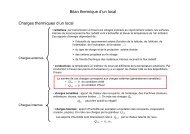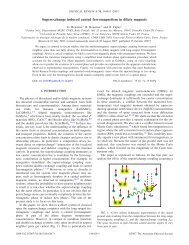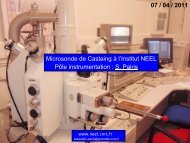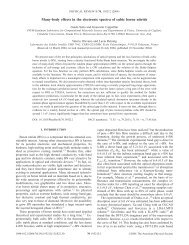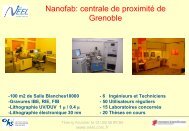Activity Report 2010 - CNRS
Activity Report 2010 - CNRS
Activity Report 2010 - CNRS
You also want an ePaper? Increase the reach of your titles
YUMPU automatically turns print PDFs into web optimized ePapers that Google loves.
Implantable brain computer<br />
interface<br />
Chair of Excellence 2008: Tetiana<br />
AKSENOVA<br />
Coordinator: Corinne MESTAIS (Léti).<br />
Severe motor disabilities require the<br />
development of new communication<br />
pathways to allow the patient controlling<br />
efficiently and safely external aids, such<br />
as wheelchairs and prostheses. The<br />
current method consists in redirecting the<br />
injured nerves into non-essential muscles<br />
and using the electric signals associated<br />
to muscle contraction to monitor the<br />
patient’s intention.<br />
The aim of the “Brain-Computer<br />
Interface” project (BCI) is to directly<br />
interpret the brain’s neural activity and to<br />
translate it into useful command signals.<br />
This project therefore relies on the<br />
development of nanostructured<br />
microelectrodes for peri- or intra-cranial<br />
neuron recording and stimulation - one of<br />
the goals of Clinatec ® . Furthermore,<br />
“motor signals” are relatively large in the<br />
brain, and can thus be discriminated from<br />
the other neural activity.<br />
Fig. 9: Scheme of the brain-computer interface<br />
experiments.<br />
Top: training stage, the recorded signals are<br />
used to calibrate the Iterative N-way Partial<br />
Least Squares projection algorithm.<br />
Bottom: the algorithm is used to command the<br />
reward distributor.<br />
SCIENTIFIC REPORT<br />
In fact, this work consists in developing<br />
and implementing innovative signal<br />
processing algorithms to analyze<br />
Electrocorticographic signals (ECoG:<br />
electric signals recorded at the brain<br />
surface). Rats were trained to press a<br />
pedal to get food at their will and ECoG<br />
signals were recorded. A first set of rats<br />
was used to build a “predictor” of the<br />
animal’s intention. The algorithm was<br />
then implemented in real time as an<br />
order to control the food reward<br />
independently of the pedal position (Fig.<br />
9).<br />
The results obtained are quite<br />
impressive, and clearly demonstrate that<br />
it is possible to monitor the animal<br />
intentions in this way. Also, the detection<br />
is stable for several months without<br />
recalibration, which is very important for<br />
future patient rehabilitation (Fig. 10).<br />
This Brain Computer Interface system is<br />
currently applied to primates to control a<br />
motorized arm (Fig. 11).<br />
Please read the corresponding Highlight<br />
at the end of this report for further<br />
information<br />
Fig. 10: Plot of the recorded observation points<br />
as a function of the first and second principal<br />
components of the predictor, at the beginning<br />
(left) and at the end (right) of the experiment.<br />
Fig. 11: A real-time brain computer interface<br />
experiment. The rat presses the pedal but<br />
decision whether to give a reward is made on<br />
the basis of the recorded ECoG signal.<br />
The success of this stage is essential to<br />
strongly demonstrate that electrocortical<br />
electrodes could be used in human to<br />
control external mechanical devices and<br />
thus rehabilitate paralyzed people. For<br />
this purpose, it is necessary to further<br />
improve the reliability of the detection.<br />
FURTHER READING:<br />
Neural Computation, 21, 2648–2666,<br />
(2009)<br />
Filtering out of Artifacts of Deep Brain<br />
Stimulation Using Nonlinear<br />
Oscillatory Model<br />
31






